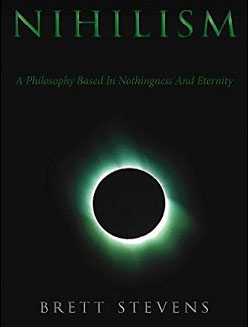Descent into a Welfare State
No one wants to admit unpopular things. You either rise from dominance (strength) or prestige (popularity), and as societies age, the latter matters more than the former. As a result, people pander to what they think the group will support, something we call the Committee Problem.
As a result, human groups become giant echo chambers for anti-realistic ideas while diminishing realistic ideas if they can. Leftists start with the anti-realistic idea of “equality” and so everything they preach is a lie; conservatives, trying to keep up, struggle to adopt the same manipulation tactics.
Remember the furore over Kevin Williamson pointing out that Appalachia was nonfunctional and should have its welfare state revoked because it did nothing but facilitate abuse and the persistence of people with no purpose?
“The draw,” the monthly welfare checks that supplement dependents’ earnings in the black-market Pepsi economy, is poison. It’s a potent enough poison to catch the attention even of such people as those who write for the New York Times. Nicholas Kristof, visiting nearby Jackson, Ky., last year, was shocked by parents who were taking their children out of literacy classes because the possibility of improved academic performance would threaten $700-a-month Social Security disability benefits, which increasingly are paid out for nebulous afflictions such as loosely defined learning disorders. “This is painful for a liberal to admit,” Kristof wrote, “but conservatives have a point when they suggest that America’s safety net can sometimes entangle people in a soul-crushing dependency.”
In effect, welfare has made Appalachia into a big and sparsely populated housing project — too backward to thrive, but just comfortable enough to keep the underclass in place. There is no cure for poverty, because there is no cause of poverty — poverty is the natural condition of the human animal. It is not as though labor and enterprise are unknown here: Digging coal is hard work, farming is hard work, timbering is hard work — so hard that the best and brightest long ago packed up for Cincinnati or Pittsburgh or Memphis or Houston.
“The government gives people checks, but nobody teaches them how to live,” says Teresa Barrett, a former high-school principal who now publishes the Owsley County newspaper. “You have people on the draw getting $3,000 a month, and they still can’t live. When I was at the school, we’d see kids come in from a long weekend just starved to death. But you’ll see those parents at the grocery store with their 15 cases of Pepsi, and that’s all they’ve got in the buggy — you know what they’re doing. Everybody knows, nobody does anything. And when you have that many people on the draw, that’s a big majority of voters.”
Appalachia shows us the same problems we see with Communism: when you pay people to be useless, soon everyone becomes useless, or at least enough of them do that your society is gridlocked by inactivity, much as the modern West is gridlocked by laws.
The French Revolutionaries found this soon after the Revolution. When everyone is equal, no one wants to work on the farms, so you end up with not enough food. Sadly they did not simply eat each other, since they were obviously mentally deficient.
Even more, all egalitarian programs involve taking money, wealth, power, and prestige from the thriving and giving it to the flailing. This creates a massive market distortion as taxes bite, and since the costs are passed on to the consumer, prices go up (“inflation”).
Over time, a welfare state leads to higher prices and lower wages; this is made worse by women in the workforce, diversity, affirmative action, high regulatory costs, and lawsuits (based on those regulations). Eventually you get a stagnant market for workers:
This figure shows that the stakes of rising inequality for the broad American middle class are enormous. The figure compares the income growth of the middle three-fifths of American households since 1979 to their income growth had there been no growth in inequality. In 2007, the last year before the Great Recession, the average income of the middle 60 percent of American households was $76,443. It would have been $94,310, roughly 23 percent (nearly $18,000) higher had inequality not widened (i.e., had their incomes grown at the overall average rate—an overall average buoyed by stratospheric growth at the very top). The temporary dip in top incomes during the Great Recession did little to shrink that inequality tax, which stood at 16 percent (nearly $12,000) in 2011.
Few people realize how bad things have become, but after the welfare programs of the early 1960s merged with the welfare programs of the 1930s, America became a mixed economy, or socialism fueled by taxes on capitalist markets.
That created constant inflation, even worse than the first income tax in 1913 did, precipitating the Great Depression, by continually removing wealth from the markets and giving it away, which reduced its value and drove up prices.
At that point, the American economy became almost as controlled as the Soviet one did: all economic activity depended on the money government sent out every month. Without that money to subsidize the consumer industry, things would be moving a lot more slowly.
Diversity and civil rights proved the magic combination to force this into every area of American life. If you were not a minority, you needed to hire them, rent to them, sell to them, and associate with them in order to avoid having the government come after you like in Little Rock and Ruby Ridge.
The perils of a government-centered economy include the slowdown that comes with rampant inflation and centralized economic control. Big companies pass on their new costs to the consumers. But salaries can do no such thing, and remain frozen in time:
After adjusting for inflation, however, today’s average hourly wage has just about the same purchasing power it did in 1978, following a long slide in the 1980s and early 1990s and bumpy, inconsistent growth since then. In fact, in real terms average hourly earnings peaked more than 45 years ago: The $4.03-an-hour rate recorded in January 1973 had the same purchasing power that $23.68 would today.
Add to this the effect of another hundred million people in the country who are taking up housing, getting hired first, receiving government benefits, and being protected by law enforcement and you can see why the American Dream died. Everything became too expensive and Whites were the obvious scapegoat.
The reality is that anytime you get a group of humans together, they avoid big issues and focus on easy ones that unite the group, which means that people fixated on minor problems and throw money at them instead of making infrastructure and institutions strong.
At some point, we think, the American worker will tire of throwing over half of his income into the bonfire of diversity taxes, and will demand Regime Change. Possibly that point has already arrived.
Tags: affirmative action, diversity, entitlements, inflation, taxation, wages, welfare










